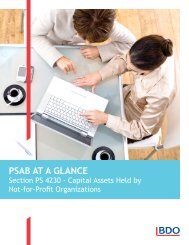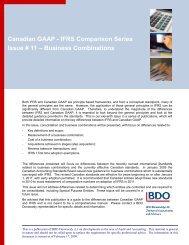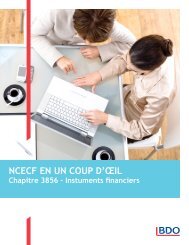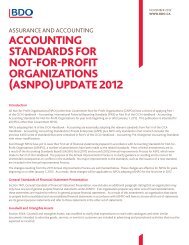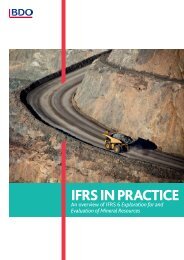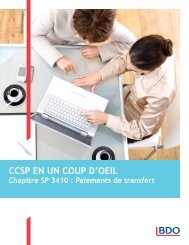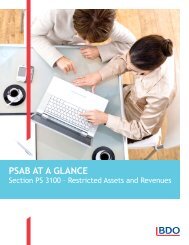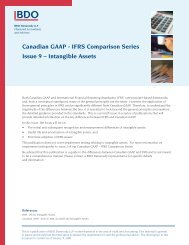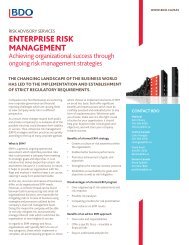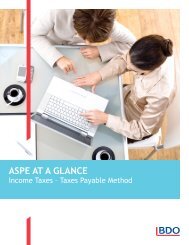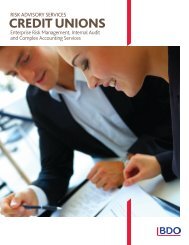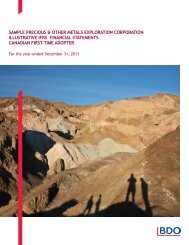Need to Know: IFRS 10 - Consolidated Financial ... - BDO Canada
Need to Know: IFRS 10 - Consolidated Financial ... - BDO Canada
Need to Know: IFRS 10 - Consolidated Financial ... - BDO Canada
- No tags were found...
You also want an ePaper? Increase the reach of your titles
YUMPU automatically turns print PDFs into web optimized ePapers that Google loves.
16 <strong>IFRS</strong> <strong>10</strong> <strong>Consolidated</strong> <strong>Financial</strong> Statements7.2.3. Relevant activities of structured entitiesA structured entity raises funds from the issue of various grades of fixed rate notes and uses the proceeds <strong>to</strong> acquirea portfolio of high credit quality variable rate residential mortgage loans. The loans are capable of being prepaid,and in practice a small proportion are expected <strong>to</strong> be prepaid either in whole or in part. The cash flow differencesbetween the variable rate interest receivable and fixed rate interest payable are hedged using interest rate swaps. Theactivities that have the most significant effect on the structured entity’s returns are:––Sourcing and acquiring the residential mortgage loans––Moni<strong>to</strong>ring prepayment rates––Determining how the arrangement is hedged––Investing excess funds <strong>to</strong> generate interest income (which could arise from prepaid mortgages)––Managing mortgage assets in the event of default.7.2.4. Can a structured entity have no relevant activities?Although they might appear <strong>to</strong> have been set up on ‘au<strong>to</strong>pilot’ with no substantive decisions <strong>to</strong> be takensubsequently, in practice there are very few structured entities that do not have any relevant activities. However, ifthere really were no decisions at all, then no inves<strong>to</strong>r would control (and therefore consolidate) the structured entity.This is regardless of whether an inves<strong>to</strong>r sponsored or designed the structured entity and had exposure <strong>to</strong> variablereturns. Consequently, it is possible that there will be a very small number of SPEs that were previously consolidatedunder SIC-12, due <strong>to</strong> an entity being exposed <strong>to</strong> a majority of benefits arising from the SPE’s activities, that will notbe consolidated under <strong>IFRS</strong> <strong>10</strong>.However, it is necessary <strong>to</strong> consider the meaning of relevant activities very broadly. For example, in a true au<strong>to</strong>pilotstructure, if one party <strong>to</strong> the arrangement has the unilateral ability <strong>to</strong> wind up the structured entity at any time,that would be regarded as a relevant activity as that party would have the ability <strong>to</strong> affect returns by cancelling thearrangement. Alternatively, an arrangement might have activities that are contingent on specified future events. Thefollowing example illustrates this point.Example 2 – Relevant activities contingent on a future event [<strong>IFRS</strong> <strong>10</strong>.B53 Application Example 11]An investee’s only business activity, as specified in its founding documents, is <strong>to</strong> purchase receivables andservice them on a day <strong>to</strong> day basis for its inves<strong>to</strong>rs. The servicing on a day <strong>to</strong> day basis includes the collectionand passing on of principal and interest payments as they fall due. Upon default of a receivable, the investeeau<strong>to</strong>matically puts the receivable <strong>to</strong> an inves<strong>to</strong>r as agreed separately in a put agreement between the inves<strong>to</strong>rand the investee. The only relevant activity is managing the receivables on default because it is the only activitythat can significantly affect the investee’s returns. Managing the receivables before default is not a relevantactivity because it does not require substantive decisions <strong>to</strong> be made that could significantly affect the investee’sreturns – the activities before default are predetermined and amount only <strong>to</strong> collecting cash flows as they falldue and passing them <strong>to</strong> inves<strong>to</strong>rs. Therefore, only the inves<strong>to</strong>r’s right <strong>to</strong> manage the assets on default should beconsidered when assessing the overall activities of the investee that significantly affect the investee’s returns. Inthis example, the design of the investee ensures that the inves<strong>to</strong>r has decision-making authority over the activitiesthat significantly affect the returns at the only time that such decision-making authority is required. The termsof the put agreement are integral <strong>to</strong> the overall transaction and the establishment of the investee. Therefore, theterms of the put agreement <strong>to</strong>gether with the founding documents of the investee lead <strong>to</strong> the conclusion that theinves<strong>to</strong>r has power over the investee even though the inves<strong>to</strong>r takes ownership of the receivables on default andmanages the defaulted receivables outside the legal boundaries of the investee.



